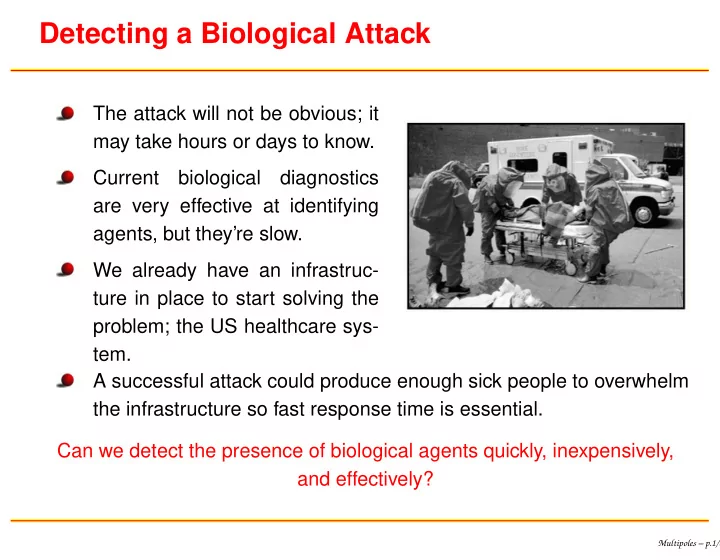

Detecting a Biological Attack The attack will not be obvious; it may take hours or days to know. Current biological diagnostics are very effective at identifying agents, but they’re slow. We already have an infrastruc- ture in place to start solving the problem; the US healthcare sys- tem. A successful attack could produce enough sick people to overwhelm the infrastructure so fast response time is essential. Can we detect the presence of biological agents quickly, inexpensively, and effectively? Multipoles – p.1/8
A Micro-Cantilever for Biological Detection Fabricate a diving-board-shaped can- tilever 50 x 200 µm using standard mi- crochip manufacturing methods. Coat the top surfaces with antibodies for protein markers for specific diseases. The targeted proteins bind to the can- tilever causing it to bend. The more pro- teins that bind the greater the bending. Detect the bending with a laser or other method. A fast, inexpensive, sensitive biosensor! Multipoles – p.2/8
Molecular Fields Consider the following charge distributions that characterize two, electrically-neutral antibodies. Assume the best way to bind with the bioagent is on the positive side of the antibody and where the field is strongest. What is the best way to orient the antibodies on the cantilever? How does the field depend on the distance from the center of charge? Restrict your attention to the plane shown in the figure. 2q 2q d d/2 d/2 −4q d −2q 2q Multipoles – p.3/8
Dipole Potential z 2 1 0 � 1 � 2 4 2 V dipole 0 � 2 � 4 � 2 � 1 0 1 y 2 Multipoles – p.4/8
For Any Charge Distribution r - charge to space point r ′ - charge distribution r - space point � � � Multipoles – p.5/8
Quadrupole Potential 4 2 0 V quad � 2 � 4 � 1 1 0 z 0 1 y � 1 Multipoles – p.6/8
Final Orientations 2q 2q d d/2 −4q d d/2 −2q 2q Multipoles – p.7/8
r -Dependence of Different Charge Distributions 1.00 Red � Point Charge Blue � Dipole 0.50 Green � Quadrupole 0.20 � � � � E 0.10 � 0.05 0.02 0.01 0 2 4 6 8 10 r Multipoles – p.8/8
Recommend
More recommend